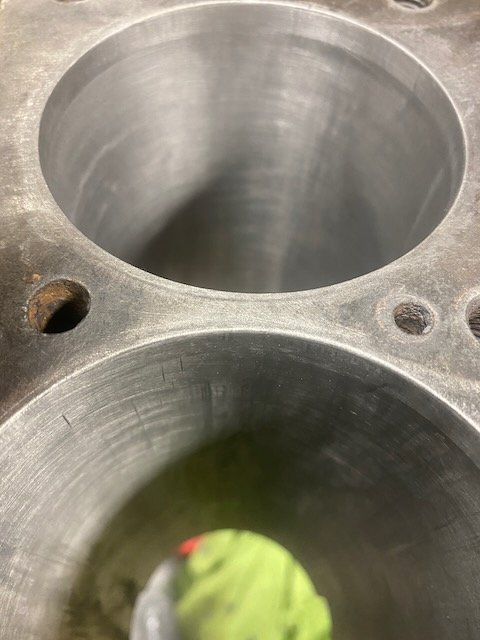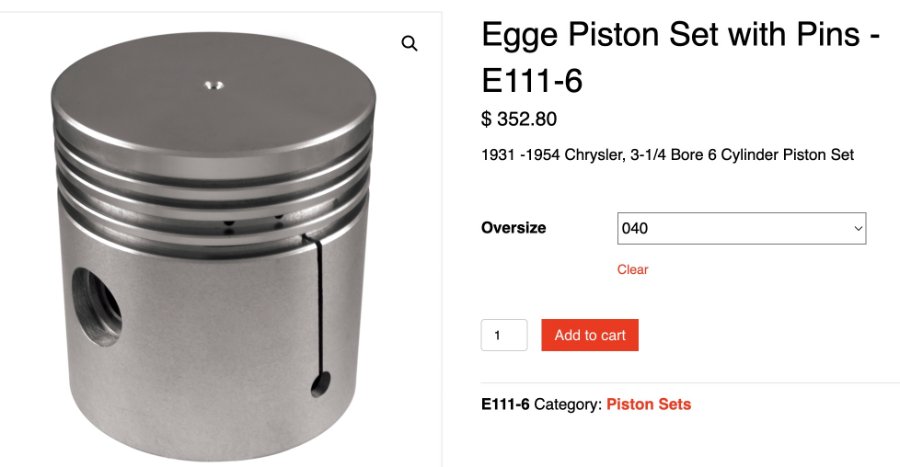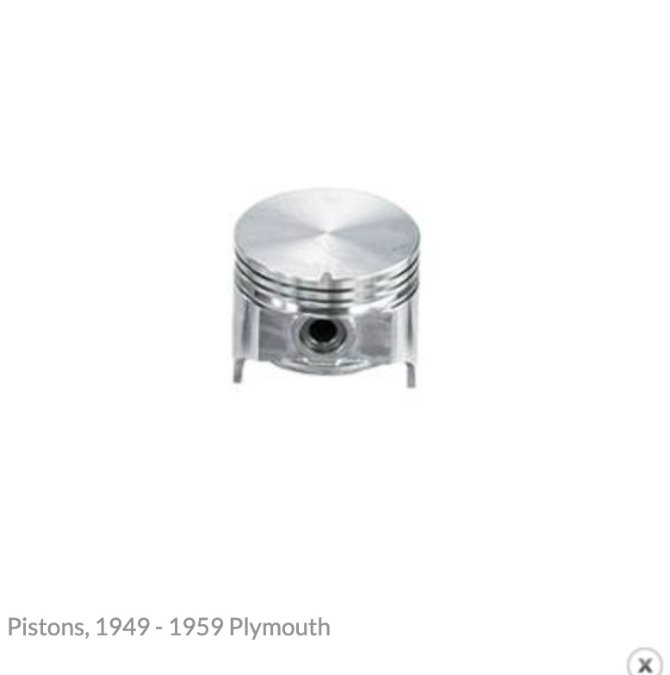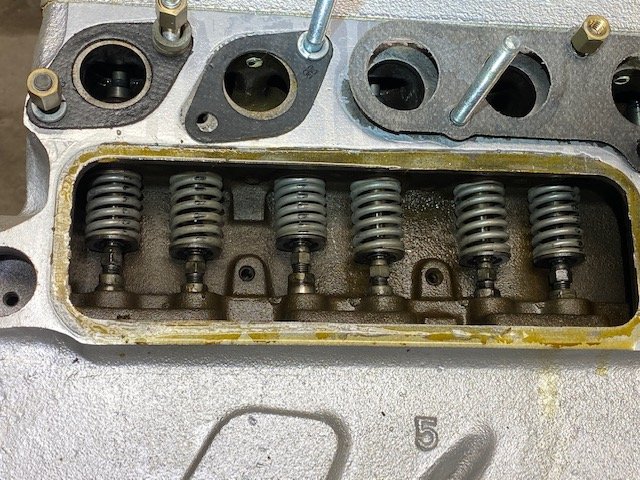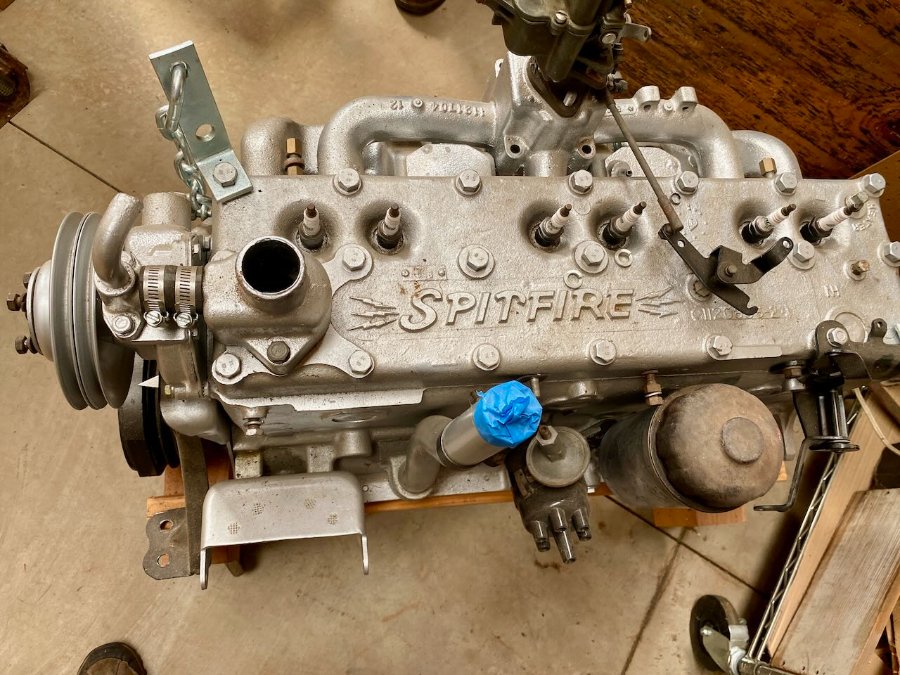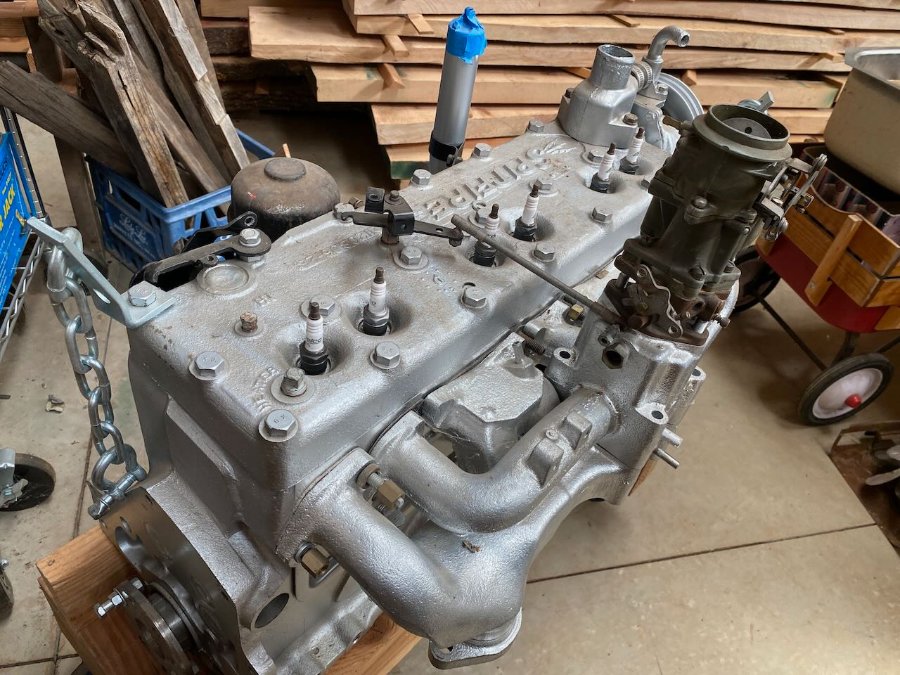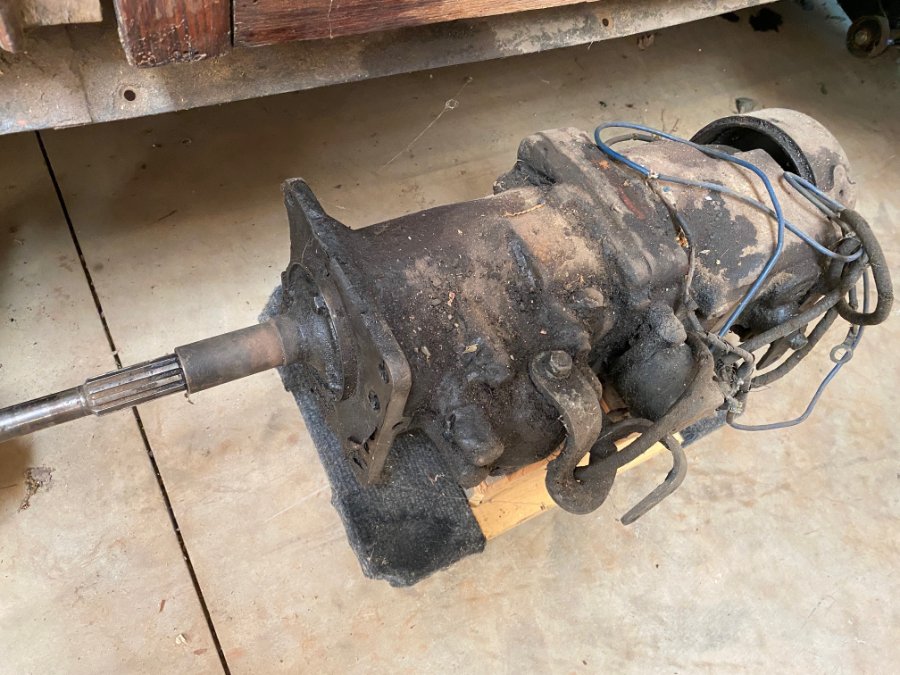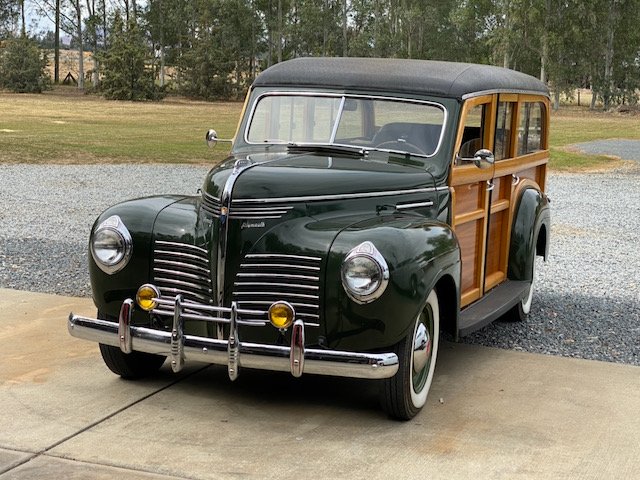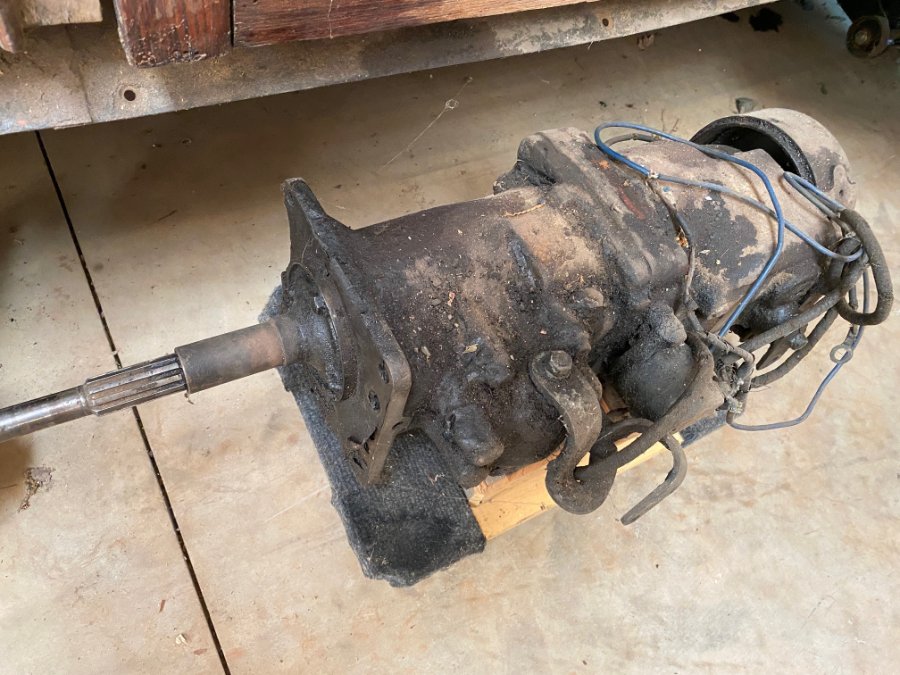-
Posts
1,196 -
Joined
-
Last visited
-
Days Won
12
Content Type
Links Directory
Profiles
Articles
Forums
Downloads
Store
Gallery
Blogs
Events
Everything posted by Bob Riding
-
I stand corrected! Proof from a 1941 owner's "How To Fully Enjoy Your Beautiful New Plymouth booklet. It states: "Among the many features that make the Plymouth engine outstanding are...aluminum alloy pistons" scan1.pdf scan2.pdf
-
Luck favors the persistant!
-
Good news from the machine shop - the 230 cid motor that I pulled from the '56 Suburban passes muster for the block, rods, crank, cam, valves, valve seats, springs and head. Unfortunately, there was enough vertical scoring on the pistons that they needed to be bored over 0.040, which means I need to buy new pistons. I did some research between our favorite vendors based on price, but then I wondered if there were any significant quality difference between them on pistons and rings. I tend to think that "Made in the USA" get's you a superior part. NOS is, of course, cast iron- new are typically aluminum alloys. Not sure where each vendor sources their parts but I'm assuming that Roberts and Bernbaum are using NOS, while Egge makes their own in the US, or used to. Here's what I found on price for pistons+rings: Summit Racing New $325 Aluminum Roberts Motor Parts NOS? $675 Cast Iron Kanter New $717 ? Andy Bernbaum Auto Parts NOS? $720 Cast Iron Vintage Power Wagons New $774 Cast Iron Egge New $932 Aluminum Small piston in photo is Summit Racing's offering, which looks different from the others.
-
Another satisfied @keithb7 viewer!
-
hey keith- Where was the dipstick location on your '53 motor? I can't seem to zero in on where they put it!
-
UPDATE: Pleasant surprises yesterday- I pulled the pan after removing the oil drain plug. Nothing came out, but there was enough residual oil in the bottom of the pan that when I rotated it on the engine stand I had drips of what looked like brand new engine oil. It took a while to get the pan off, as the cork gasket and whatever sealant they used in 2003 was tough to scrape off. There were little bits of cork gasket in and around the inside of the motor, so I rigged up a shop vac with a small hose and got it all out (at least what I could see). I pulled off the main caps and then the rod caps, but checked them with the torque wrench first to see what they were torqued to from the rebuild. Chrysler calls for 85 ft lbs for the mains and 40-45 ft lbs for the con rod nuts. Both checked out. The residual lube that was present was gray colored, and no sign of wear -it was still slippery. I cleaned the bearing surfaces and added red assembly lube (tops only as I didn't pull the pistons), and re-torqued them to specs. Inside the engine was clean, no rust. Valve springs and tappets looked new, as did the underside of the pistons and bearing surfaces. Top of the pistons as seen through the sparkplug hole were silver. The cylinder walls had good hatch marks. Sparkplugs looked like they had never been fired. I slowly rotated the engine (sparkplugs removed) and there was significant resistance, but it was smooth. Startup may be in a few months, but I want to get the motor ready ahead of time. Questions: Should I still put Marvel MO or engine oil, in the cylinders? How can I make sure I got all of the little cork bits out of the crankcase (or does it matter)? How do I lubricate the piston-side of the bearings, or is that a non-issue? I don't want to pull the pistons unless I have to. Are the AC Delco R45 sparkplugs a good choice, or is there something better? Anything I need to do to the water pump? No zerc fitting present, but it is 20 yrs old. Thanks!
-
Great, thanks!
-
Excellent. I bought one too. How did you wire it? Did you leave your old voltage regulator in place and bypass it?
-
Nice pictures and trip description! That is also a great looking Plymouth- and to think that you did it all on 6 volts! What brand of alternator did you buy originally? I want to avoid it
-
Yes, it has an oil filter and it might be full flow. I heard Chrysler did that at some point in the 50's.
-
I have the opportunity to purchase a rebuilt C54 Chrysler Spitfire 265 motor from a friend at a very good price. I was looking for a powerplant for my stalled '52 Suburban project and after some research and help from Forum members, I think I can fit it into the wagon with only minor modifications. I have the bill of sale from the machine shop and it looks like they did a thorough job: They magna-fluxed and hot-tanked the block, resurfaced the head, installed new valve guides & lifters, rebored and honed .030 over cylinders. Installed new 030 over pistons and rings, reconditioned the rods with new pins and bushings, ground and polished the crankshaft, installed new rod and main bearings. Fitted new cam bearings, and installed a new oil pump. They then reassembled the long block. Costs were: parts $203, labor $890, total $1109. The year was 2003! In one of his excellent videos, @keithb7 states that rebuilding a Mopar flathead, parts alone will run you about $500/cylinder. I can testify to that price range, as I have a 230 motor in a local machine shop for hot tanking and magna-fluxing. They quoted me $5,000 to rebuild it and 6-9 months to get it done! I will be able to purchase the Spitfire for less than the cost of the original rebuild so obviously, I MUST BUY IT! I'm excited about resurrecting the motor, but not sure how to proceed. It was never run, and has been in dry storage for almost 20 years. I know - Marvel Mystery oil in the cylinders and using a drill in the the oil pump shaft to lube the bottom end - should I use standard 10-40w with an additive like Lucas TB Zinc-Plus for break in oil? Any other cautions/suggestions?
-
Marc- thanks for posting. Where did you get the carb rebuild kit, and are you happy with it?
-
Good to know, thanks!
-
-
@Lorenand others have said as much. Thanks for the reference!
- 7 replies
-
- chrysler 265
- fast 2nd gear
-
(and 1 more)
Tagged with:
-
It's a 23"
- 14 replies
-
- 1
-

-
- weber 32/36
- carburator
-
(and 3 more)
Tagged with:
-
LOL. Yes, I only have the Langdon copy because I was going to put my 218 from the woody in the '52 Suburban I have in the works, but ended up getting a rebuilt Chrysler 360 for not much money and the Weber clone would be too small. I tend to get out ahead of my skis on parts buying, as I want to make sure i have what's needed so as not to slow down the rebuild...
- 14 replies
-
- weber 32/36
- carburator
-
(and 3 more)
Tagged with:
-
Interesting. Why not the 32/36?
- 14 replies
-
- weber 32/36
- carburator
-
(and 3 more)
Tagged with:
-
Great comparisons. I did have Tom Langdon cutout the bottom of my '52 stock oil bath air cleaner and fit it with a paper filter. It sits low on the carb. Linkage issues aside, what do you think about the differences, if any, about performance and reliability?
- 14 replies
-
- weber 32/36
- carburator
-
(and 3 more)
Tagged with:
-
While I'm waiting on the machine shop to get back to me on what needs to be done to the 230 cid motor, I thought I'd experiment with carburetion. I will be using the larger "Power Pack" intake that came with the motor, which came from the factory with the 2bbl Stromberg WW carb, which @Loren really likes. I had earlier purchased Langdon's Stovebolt Weber clone 32/26 2bbl carb for another project, and it's still new in the box. Everyone who has installed the Langdon carb seems to really like it. I was trying to look up the CFM numbers for both to compare, but with no luck. Assuming I did a clean and rebuild of the Stromberg, which carb would be a better choice? This will be used in my '40 Plymouth wagon - no racing, just regular driving.
- 14 replies
-
- 1
-

-
- weber 32/36
- carburator
-
(and 3 more)
Tagged with:
-
I just PM'd you.
-
I'm helping a fellow Forum member @PlyWoodsell his collection of '41-'54 Plymouth and Chrysler cars and parts because he is moving and has no room at the new digs. He has a newly rebuilt C54 256 cu in motor he's selling with a '40 Chrysler 3spd with factory OD. (See Classifieds) A great Forum post from 2015 "The Rough Field Spotters Guide for Mopar Overdrives" talks about the 1940 Chrysler OD as being a one year model where "the last year where the gear cluster and 2nd speed gear in the 3 speed transmission gave you a "fast 2nd speed". This was done with a cluster tooth count of - "14.19.25.32" and the 2nd speed gear was a 23 tooth count. After this the cluster was a tooth count of "14.19.23.32" In a recent post @Loren mentioned that my 1940 Plymouth transmission might also have a fast 2nd. Was this a company-wide change? Why didn't they continue it if it was superior to other designs?
- 7 replies
-
- chrysler 265
- fast 2nd gear
-
(and 1 more)
Tagged with:
-
What about using an old crock pot and boil with a mild degreaser Like Simple Green for a few hours?
-
I would be interested in your results with them. Are you looking for a 60 amp, 6v pos ground unit?
-
Hey Keith...I watched your video when you cleaned your carb-didn't get the brand of ultrasonic cleaner you bought. Would you buy it again?



